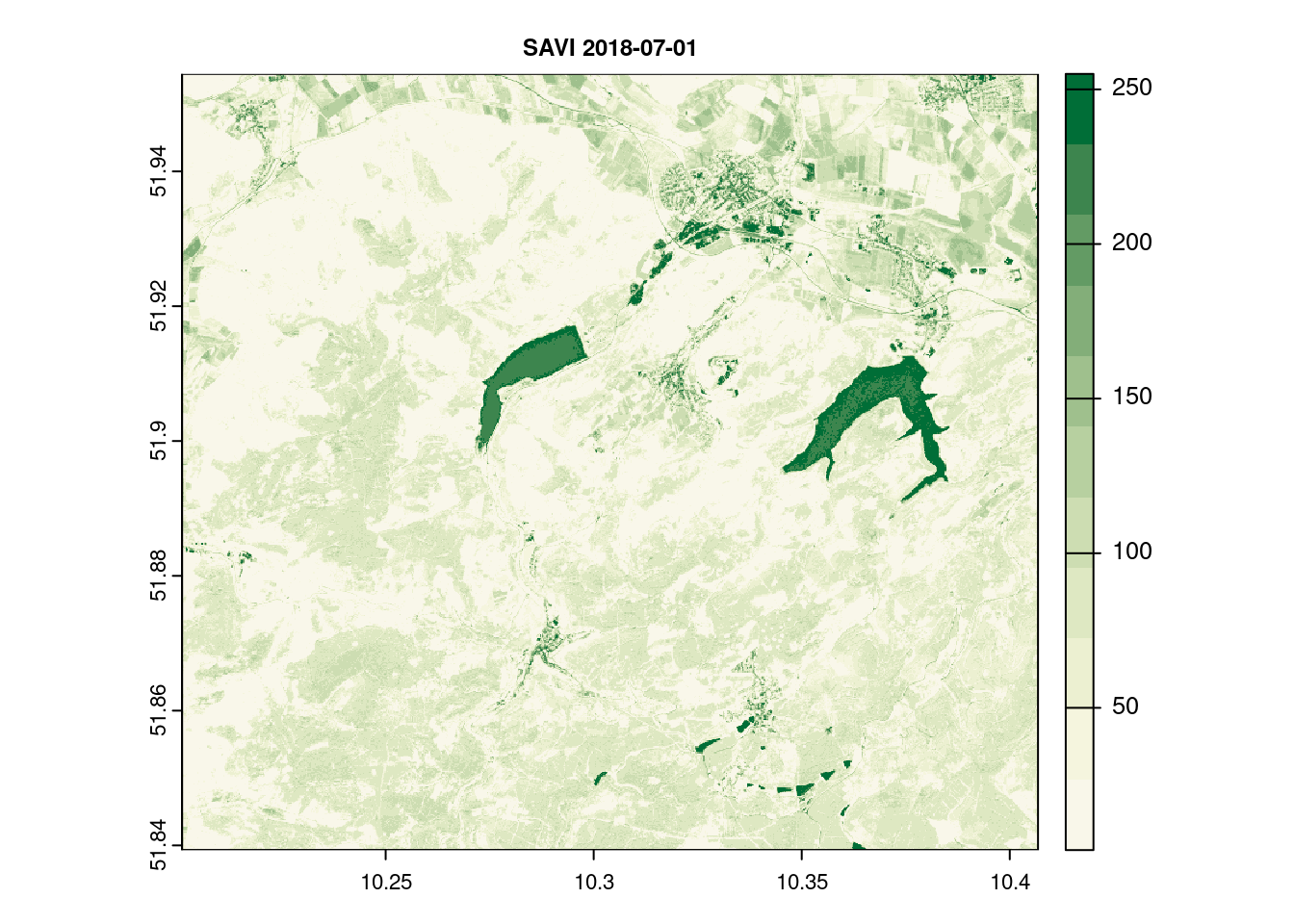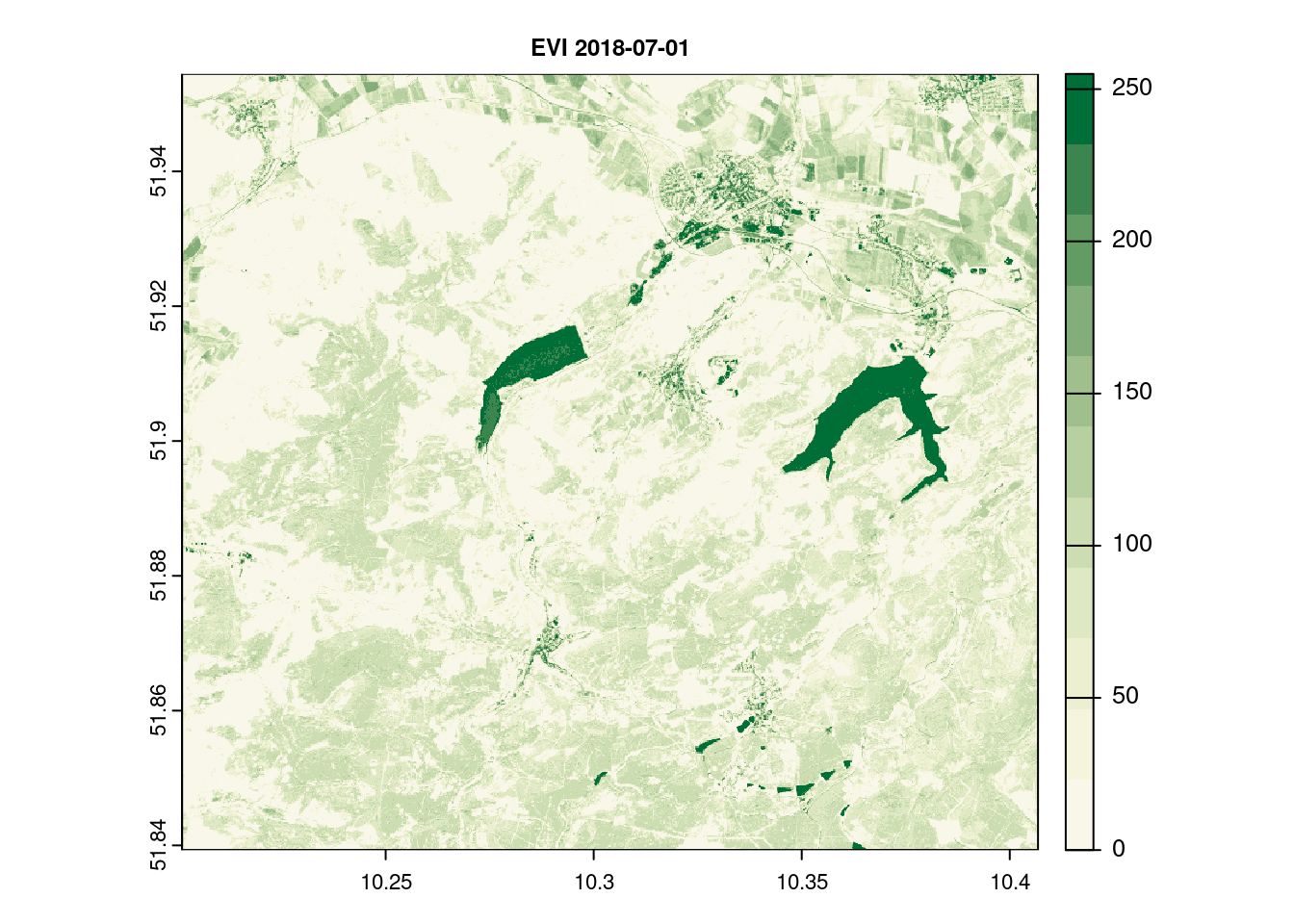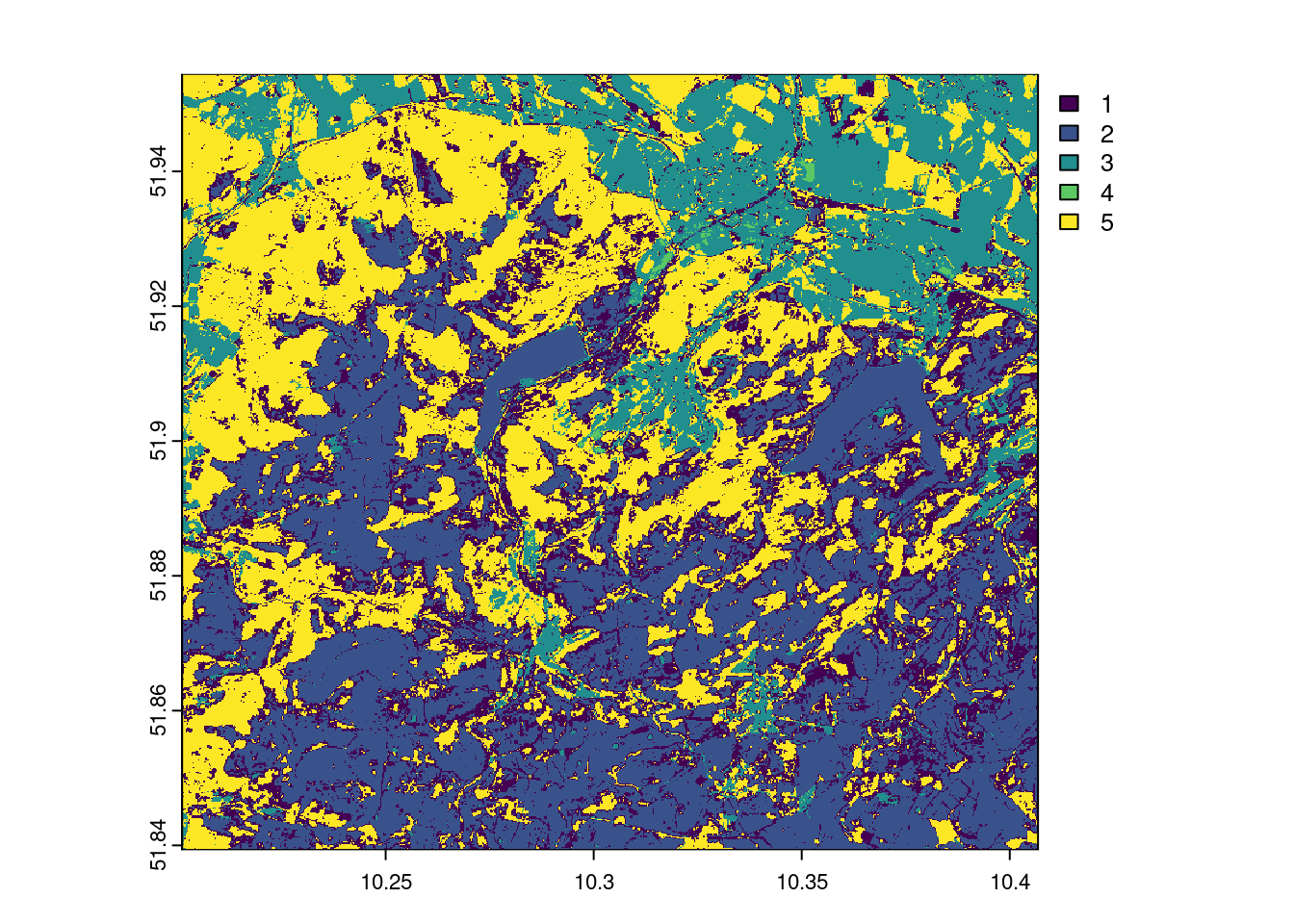# ---- 0 Projekt Setup ----
require("pacman")
#remotes::install_github("zivankaraman/CDSE")
# packages installing if necessary and loading
pacman::p_load(mapview, mapedit, tmap, tmaptools, raster, terra, stars, gdalcubes, sf,webshot, dplyr,CDSE,webshot, downloader, tidyverse,RStoolbox,rprojroot, exactextractr, randomForest, ranger, e1071, caret, link2GI, rstac, OpenStreetMap,colorspace,ows4R,httr)
#--- Switch to determine whether digitization is required. If set to FALSE, the
root_folder = find_rstudio_root_file()
ndvi.col = function(n) {
rev(sequential_hcl(n, "Green-Yellow"))
}
ano.col = diverging_hcl(7, palette = "Red-Green", register = "rg")In the geosciences, remote sensing is the only measurement technique that allows complete coverage of large spatial areas, up to the entire Earth’s surface. Its successful application requires both the use of existing methods and the adaptation and development of new ones.
Introduction
In geospatial or environmental informatics, the detection of changes to the Earth’s surface using satellite, aircraft or drone images, known as change detection analysis, is an important application. These results are often linked to biophysical, geophysical or anthropogenic processes in order to gain both a deeper understanding and the possibility of developing predictive models. Methods of image analysis are of outstanding importance for generating spatial information from the underlying processes. Since both the quantity and quality of this “image data” are playing an increasingly important role in environmental monitoring and modeling, it is becoming more and more necessary to integrate “big data” concepts into the analyses. This means performing reproducible analyses with large amounts of data (>> 1 TB). This is essential for both scientific knowledge gain and future societal challenges.
As already explained in the introduction, we start with a scalable change detection analysis of forest damage in low mountain ranges, which is a typical application-oriented task. Scalable means that we limit the analysis to a manageable area, the Nordwestharz, and to two time slices. However, the resulting algorithm can be applied to different or larger areas and to more time slices.
Goals
This example shows how change detection methods can be applied conventionally to individual satellite scenes and in a modern way in cloud computing environments using rstac (Brazil Data Cube Team 2021) and gdalcubes (Appel and Pebesma 2019) or openeo (Lahn 2024). In addition to classical supervised classification methods such as Maximum Likelihood and Random Forest, the bfast (Verbesselt, Zeileis, and Herold 2012) is used, which includes an unsupervised method for detecting structural breaks in vegetation index time series.
Other packages used in this tutorial include stars (Pebesma 2019), tmap (Tennekes 2018) and mapview (Appelhans et al. 2019) for creating interactive maps, sf (Pebesma 2018) for processing vector data, and colorspace (Zeileis et al. 2020) for visualizations with accessible colors.
This study employs a variety of approaches to time series and difference analyses with different indices, using the Harz Mountains as a case study for the period between 2018 and 2023. The objective is to analyze or classify the data.
Information from satellite imagery
Unprocessed satellite images are not necessarily informative. While our eyes can interpret a true-color image relatively conclusively and intuitively, a reliable and reproducible, i.e. scientifically sound, interpretation requires other approaches. A major advantage of typical image analysis methods over visual interpretation is the derivation of additional, so-called invisible information.
To obtain useful or meaningful information, e.g. about the land cover in an area, we have to analyze the data according to the question at hand. Probably the best known and most widely used approach is the supervised classification of image data into categories of interest.
In this unit, you will learn about the classification of satellite image data. This includes both data acquisition on the Copernicus portal and the various steps from digitising the training data to evaluating the quality of the classifications.
We will cover the following topics:
- Theoretical principles
- Case Study Harz Mountains
- Preparing the work environment
- Retrieving Sentinel and auxilliary data
- Unsupervised classification (k-means clustering)
- Recording training areas.
- Supervised classification (Random Forest, Maximum Likelihood)
- Estimating model quality
Theoretical principles
Please note that all types of classification usually require extensive data pre-processing. The focus is then on model building and quality assessment, which can be seen as the technical basis for classification, in order to finally derive the interpretation of the results in terms of content in the data post-processing.
We will go through this process step by step.
Unsupervised Classification - k-means clustering
Probably the best-known unsupervised classification technique is K-means clustering, which is also referred to as the “simplest machine learning algorithm”.
K-means clustering is a technique commonly used in satellite image classification to group pixels with similar spectral characteristics. Treating each pixel as an observation, the algorithm assigns pixels to clusters based on their spectral values, with each cluster having a mean (or centroid) that represents its central spectral signature. This results in the segmentation of the image into distinct regions (similar to Voronoi cells) corresponding to land cover types, such as water, vegetation or urban areas, facilitating further analysis. It is often used to obtain an initial overview of whether the raster data can be sufficiently separated in feature space.
Figure: Convergence of k-means clustering from an unfavorable starting position (two initial cluster centers are fairly close). Chire [CC BY-SA 4.0] via wikipedia.org
Supervised classification
In supervised land cover classification, a model is derived from a limited amount of training land cover data that predicts land cover for the entire data set. The land cover types are defined a priori, and the model attempts to predict these types based on the similarity between the characteristics of the training data and the rest of the data set.
 Classifiers (e.g. the maximum likelihood classifier) or machine learning algorithms (such as Random Forest) use the training data to determine descriptive models that represent statistical signatures, classification trees or other functions. Within the limits of the quality of the training data, such models are suitable and representative for making predictions for areas if the predictors from the model are available for the entire area.
Classifiers (e.g. the maximum likelihood classifier) or machine learning algorithms (such as Random Forest) use the training data to determine descriptive models that represent statistical signatures, classification trees or other functions. Within the limits of the quality of the training data, such models are suitable and representative for making predictions for areas if the predictors from the model are available for the entire area.
We now want to predict the spatial characteristics of clear-felling/no forest using a maximum likelihood classification and random forest, and apply standard methods of random validation and model quality assessment.
The goal is to separate clearcuts from all other pixels and to quantify the differences between 2018 and 2022.
Maximum Likelihood Classification
Maximum likelihood classification assumes that the distribution of data for each class and in each channel is normally distributed. Under this assumption, the probability that a particular pixel belongs to a particular class is calculated. Since the probabilities can also be specified as a threshold, without this restriction, all pixels are assigned regardless of how unlikely they are. Each pixel is assigned to the class that has the highest probability (i.e., the maximum probability).

Random forest
Random forests can be used for both regression and classification tasks, with the latter being particularly relevant in environmental remote sensing. Like any machine learning method, the random forest model learns to recognize patterns and structures in the data itself. Since the random forest algorithm also requires training data, it is also a supervised learning method.  !
!
Figure: Simplified illustration of data classification by random forest during training. Venkata Jagannath [CC BY-SA 4.0] via wikipedia.org
A random forest algorithm learns from the data by creating random decision trees – hence the name. For classification tasks, the algorithm takes a suitable instance of a decision tree from the training data set and assigns the corresponding class to the pixel. This is repeated with all available decision trees. Finally, the pixel is assigned to the class that has the most trees, according to the winner-takes-all principle.
From a pragmatic point of view, classification tasks generally require the following steps:
- Creation of a comprehensive input data set that contains one or more raster layers.
- Selection of training areas, i.e. subsets of the input data set for which the land cover type is known to the remote sensing expert. Knowledge of the land cover can be obtained, for example, from one’s own or third-party in situ observations, management information or other remote sensing products (e.g. high-resolution aerial photographs).
- Training a model using the training sites. For validation purposes, the training sites are often subdivided into one or more test and training sites to evaluate the performance of the model algorithm.
- Applying the trained model to the entire data set, i.e. predicting the land cover type based on the similarity of the data at each site to the class characteristics of the training data set.
Change detection case study: Harz Mountains
Since 2018, there has been a notable increase in the incidence of extensive forest dieback in the Harz Mountains. During this period, the combination of repeated years of drought, extreme heat waves and the resulting weakening of the spruce trees led to an exponential increase in the population of bark beetles. The combined impact of these factors resulted in the extensive mortality of spruce stands across an area of approximately 30,000 hectares over a period of approximately five to six years. This equates to approximately 35% of the total forest area of the Harz.
It is important to note that the prolonged drought in 2018, 2019 and 2020, which is considered one of the most severe in the region, has significantly exacerbated the damage in the Harz Mountains.
In this context, a time series analysis or a change detection analysis is an essential technique for quantifying and localising the damage and characterising its dynamics.
Setting up the work environment
However, the work environment is usually loaded first.
Please add any missing or defective packages in the above setup script (if error messages occur). On the basis of the available Sentinel data, the first step should be to identify suitable data sets for a surface classification.
Defining the Area of Interest
Please note to project to different CRS is for this examples convenience and clarity and somewhat superfluous. Only the corner coordinates of the sections are required and not the complete geometries. However, it creates more clarity for the later process to already have the data needed in different projections.
# download the Harz region from the UBA WFS server
# nre_regions <- "https://geodienste.bfn.de/ogc/wfs/gliederungen?"
# regions_client <- WFSClient$new(nre_regions,
# serviceVersion = "2.0.0",)
# regions_client$getFeatureTypes(pretty = TRUE)
#
# url <- parse_url(nre_regions)
# url$query <- list(service = "wfs",
# #version = "2.0.0", # optional
# request = "GetFeature",
# typename = "Haupteinheiten",
# srsName = "EPSG:4326"
# )
# request <- build_url(url)
#
# nre_regions_sf <- read_sf(request)
# harz = nre_regions_sf |>
# filter(NAME_ORD3 %in% c( "Oberharz"))
# plot(harz)
# harz_bbox = bb(harz,projection=4326)
# harz_32632 =sf::st_transform(harz,crs = 32632)
# harz_bbox_32632 = bb(harz_32632,projection=32632)
# Download training data which is also used for the extend
utils::download.file(url="https://github.com/gisma/gismaData/raw/master/geoinfo/train_areas_2019_2020.gpkg",destfile=file.path("../data/train_areas_2019_2020.gpkg"))
train_areas_2019_2020 = st_read(file.path("../data/train_areas_2019_2020.gpkg"))Reading layer `train_areas_2019_2020' from data source
`/home/creu/edu/gisma-courses/LV-19-d19-006-24/data/train_areas_2019_2020.gpkg'
using driver `GPKG'
Simple feature collection with 87 features and 3 fields
Geometry type: POLYGON
Dimension: XY
Bounding box: xmin: 10.21106 ymin: 51.84931 xmax: 10.39679 ymax: 51.94446
Geodetic CRS: WGS 84train_areas_2019_2020 |>
st_bbox() -> bbox
# mapping the extents and boundaries of the choosen geometries
# tmap_mode("view")
# tmap_options(check.and.fix = TRUE) +
# tm_basemap(server = c("Esri.WorldGrayCanvas", "OpenStreetMap", "Esri.WorldTopoMap","Esri.WorldImagery")) +
# #tm_shape(harz) +
# tm_polygons(alpha = 0.4)
#--- Reading the data from the directories
##--- This describes how to process the Corine land use and land cover dataset
## The necessary file can also be downloaded from the repository
## An account is required for the download https://land.copernicus.eu/pan-european/corine-land-cover
## Therefore, download the data manually and unzip
## U2018_CLC2018_V2020_20u1.tif into the data directory
## Then continue
if (!file.exists(file.path(root_folder,"data/corine_harz.tif"))){
corine = rast(file.path("../data/U2018_CLC2018_V2020_20u1.tif"))
corine = terra::project(corine,"EPSG:4326" )
corine_harz = terra::crop(corine,vect(train_areas_2019_2020))
terra::writeRaster(corine_harz,file.path(root_folder,"data/corine_harz.tif"),overwrite=TRUE)
}
corine_harz = rast(file.path(root_folder,"data/corine_harz.tif"))
# Create a forest mask from corine
# Agro-forestry areas code=22, Broad-leaved forest code=23,
# Coniferous forest code=24, Mixed forest code=25
m <- c(-100, 22, 0,
22, 26, 1,
26, 500, 0)
rclmat <- matrix(m, ncol=3, byrow=TRUE)
harz_forest_mask <- classify(corine_harz, rclmat, include.lowest=TRUE)
mapview(corine_harz)+mapview(train_areas_2019_2020,zcol="class")+harz_forest_mask# create extents
e <- ext(harz_forest_mask)
p <- as.polygons(e, crs="EPSG:4326")
cm=sf::st_as_sf(p)
harz_bbox = bb(train_areas_2019_2020,projection=4326)Step 1: Retrieving Sentinel data
Sentinel-2 is currently the most important platform for Earth observation in all areas, but especially for climate change, land use and ecological issues at all levels, from the upper micro to the global scale.
There are two operational Sentinel-2 satellites: Sentinel-2A and Sentinel-2B, both in sun-synchronous polar orbits and 180 degrees out of phase. This arrangement allows them to cover the mid-latitudes with an orbital period of about 5 days.
The Sentinel-2 data are therefore predestined to record spatial and temporal changes on the Earth’s surface (the forest was green in early summer, it has disappeared by late summer). They are ideal for timely studies before and after natural disasters, or for biomass balancing, etc.
Aternative 1: Using gdalcubes
The gdalcubes tool has been developed with the objective of facilitating the processing of extensive collections of satellite images. It has been designed to enhance the efficiency, speed, intuitiveness and interactivity of this task.
Cloud-Optimised GeoTIFFs (COGs)
Unfortunately, the official Sentinel-2 archives are anything but user-friendly. Technically, the processed product levels are available for download pre-processed as L1C and L2A products in JP2K format. The preferred file format is JP2K, which is storage efficient but has to be downloaded in its entirety locally by the user, resulting in high access costs and huge local storage requirements. The cloud-optimised GeoTIFFs (COGs) allow only the areas of interest to be downloaded and are also much faster to process. However, this requires optimised cloud services and a technically different access logic than in the traditional processing chains used so far.
SpatioTemporal Asset Catalog (STAC)
The [Spatial-Temporal Asset Catalogue] (https://stacspec.org/) (STAC) provides a common language for simplified indexing and discovery of geospatial data. A “Spatio-Temporal Asset” is a file that contains information in a specific space and time.
This approach allows any provider of spatio-temporal data (imagery, SAR, point clouds, data cubes, full motion video, etc.) to provide Spatio-Temporal Asset Catalogues (STAC) for their data. STAC focuses on an easy-to-implement standard that organisations can use to make their data available in a durable and reliable way.
Element84 has provided a public API called Earth-search, a central search catalogue for all public AWS datasets using STAC (including the new Sentinel-2 COGs), which contains more than 11.4 million Sentinel-2 scenes worldwide as of 1 November 2017.
One major challenge is the fact that most of the earth surface related remote sensing activities are heavily “disturbed” by the atmosphere, especially by clouds. So to find cloud free satellite imagery is a common and cumbersome task. This task is supported by the rstac package which provides a convenient tool to find and filter adequate Sentinel-2 images out of the COG data storage. However, to address the AOI we need to provide the extend via the bbox argument of the corresponding function stac_search(). So first we need to derive and transform the required bounding box to WGS84 geo-coordinates, easily done with the sf functions st_bbox() and st_transform(). In addition we adapt the projection of the referencing vector objects to all other later projection needs.
Querying images with rstac
Using the rstac package, we first request all available images from 2018 to 208 that intersect with our region of interest. Here, since the polygon has WGS84 as CRS, we do not need to transform the bounding box before using the stac_search() function.
# search the data stack for the given period and area
s = stac("https://earth-search.aws.element84.com/v0")
items <- s |>
stac_search(collections = "sentinel-s2-l2a-cogs",
bbox= c(bbox["xmin"],bbox["ymin"],bbox["xmax"],bbox["ymax"]), ,
datetime = c("2018-06-01/2022-09-01"),
limit = 600) |>
post_request()
items###Items
- matched feature(s): 626
- features (600 item(s) / 26 not fetched):
- S2A_32UNC_20220901_0_L2A
- S2A_32UNC_20220829_0_L2A
- S2B_32UNC_20220827_0_L2A
- S2B_32UNC_20220824_0_L2A
- S2A_32UNC_20220822_0_L2A
- S2A_32UNC_20220819_1_L2A
- S2B_32UNC_20220817_0_L2A
- S2B_32UNC_20220814_0_L2A
- S2A_32UNC_20220812_0_L2A
- S2A_32UNC_20220809_0_L2A
- ... with 590 more feature(s).
- assets:
AOT, B01, B02, B03, B04, B05, B06, B07, B08, B09, B11, B12, B8A, info, metadata, overview, SCL, thumbnail, visual, WVP
- item's fields:
assets, bbox, collection, geometry, id, links, properties, properties.sentinel:boa_offset_applied, stac_extensions, stac_version, typeThis gives us 334 matching images recorded between 2019-06-01 and 2021-09-01.
Creating a monthly Sentinel-2 data cube
To obtain a Sentinel data cube, a gdalcube image collection must be created from the STAC query result. To do this, the asset names must be explicitly named in order to apply the SCL channel with the quality characteristics per pixel (classification as clouds, cloud shadows, etc.). In this query, a filter is set to cloud cover <= 50%.
s2_collection <- stac_image_collection(items$features,
asset_names =
c("B01","B02","B03","B04","B05","B06", "B07","B08","B8A","B09","B11","SCL"),
property_filter = function(x) {x[["eo:cloud_cover"]] < 5})
s2_collectionImage collection object, referencing 78 images with 12 bands
Images:
name left top bottom right
1 S2B_32UNC_20220824_0_L2A 9.494450 52.34699 51.35264 10.61137
2 S2A_32UNC_20220812_0_L2A 8.999721 52.35046 51.35264 10.61137
3 S2A_32UNC_20220623_0_L2A 8.999721 52.35046 51.35264 10.61137
4 S2B_32UNC_20220618_0_L2A 8.999721 52.35046 51.35264 10.61137
5 S2B_32UNC_20220615_0_L2A 9.471038 52.34716 51.35264 10.61137
6 S2B_32UNC_20220519_1_L2A 8.999721 52.35046 51.35264 10.61137
datetime srs
1 2022-08-24T10:26:32 EPSG:32632
2 2022-08-12T10:36:42 EPSG:32632
3 2022-06-23T10:36:42 EPSG:32632
4 2022-06-18T10:36:34 EPSG:32632
5 2022-06-15T10:26:36 EPSG:32632
6 2022-05-19T10:36:29 EPSG:32632
[ omitted 72 images ]
Bands:
name offset scale unit nodata image_count
1 B01 0 1 78
2 B02 0 1 78
3 B03 0 1 78
4 B04 0 1 78
5 B05 0 1 78
6 B06 0 1 78
7 B07 0 1 78
8 B08 0 1 78
9 B09 0 1 78
10 B11 0 1 78
11 B8A 0 1 78
12 SCL 0 1 78The result is 118 images, i.e. approx. 1.8 images per month, from which we can now create a data cube. To do this, we use the UTM bounding box of our polygon as a spatial boundary, a spatial resolution of 10 metres, a bilinear spatial interpolation (useful for the spatially lower-resolution sentinel channels) and calculate monthly median values for all pixel values from the available images of a month. In addition, we add a buffer (b) on each side of the cube.
The gdalcube image collection can be considered as a proxy structure object which will be applied on the COGs.
st_as_sfc(bbox) |>
st_transform("EPSG:32632") |>
st_bbox() -> bbox_utm
v = cube_view(srs = "EPSG:32632", extent = list(t0 = "2018-06", t1 = "2022-09", left = bbox_utm["xmin"] - 10, right = bbox_utm["xmax"] + 10, bottom = bbox_utm["ymin"] - 10, top = bbox_utm["ymax"] + 10),
dx = 10, dy = 10, dt = "P1M", aggregation = "median", resampling = "bilinear")
vA data cube view object
Dimensions:
low high count pixel_size
t 2018-06-01 2022-09-30 52 P1M
y 5744956.9172092 5755796.9172092 1084 10
x 583230.473549458 596220.473549458 1299 10
SRS: "EPSG:32632"
Temporal aggregation method: "median"
Spatial resampling method: "bilinear"Next we create a data cube, subset the red and near infrared bands and crop by our polygon, which simply sets pixel values outside the polygon to NA. We then save the data cube as a single netCDF file. Note that this is not necessary, but saving intermediate results sometimes makes debugging easier, especially if the methods applied afterwards are computationally intensive.
Only calling a final action will start the processing on the COG-Server. In this case ‘write_ncdf’.
## ##
#|
# we "download" the data and write it t a netcdf file
s2.mask = image_mask("SCL", values = c(3,8,9))
gdalcubes_options(parallel = 16,
ncdf_compression_level = 5)
raster_cube(s2_collection, v, mask = s2.mask) |>
write_ncdf(file.path(root_folder,"../data/harz_2018_2022_all.nc"),overwrite=TRUE)kNDVI
Below, we derive mean monthly kNDVI values over all pixel time series.
ncdf_cube(file.path(root_folder,"../data/harz_2018_2022_all.nc")) |>
apply_pixel("tanh(((B08-B04)/(B08+B04))^2)", "kNDVI") |>
reduce_time("mean(kNDVI)") |>
plot(key.pos = 1, col = ndvi.col(11), nbreaks = 12)
Alternative 2: Copernicus Data Space Ecosystem API Wrapper CDSE
The CDSE package provides another simple way to get Sentinel/Copernicus data sets.
#------------
# NOTE: You must create an Copernicus account and provide the token credtials have a look at:
# https://zivankaraman.github.io/CDSE/articles/BeforeYouStart.html#accessing-cdse-data-and-services
#------------
id <- Sys.getenv("CDSE_ID")
secret <- Sys.getenv("CDSE_SECRET")
OAuthClient <- GetOAuthClient(id = id, secret = secret)
collections <- GetCollections(as_data_frame = TRUE)
collections id title
1 sentinel-2-l1c Sentinel 2 L1C
2 sentinel-3-olci-l2 Sentinel 3 OLCI L2
3 sentinel-3-olci Sentinel 3 OLCI
4 sentinel-3-slstr Sentinel 3 SLSTR
5 sentinel-1-grd Sentinel 1 GRD
6 sentinel-2-l2a Sentinel 2 L2A
7 sentinel-5p-l2 Sentinel 5 Precursor
description
1 Sentinel 2 imagery processed to level 1C
2 Sentinel 3 data derived from imagery captured by OLCI sensor
3 Sentinel 3 imagery captured by OLCI sensor
4 Sentinel 3 imagery captured by SLSTR sensor
5 Sentinel 1 Ground Range Detected Imagery
6 Sentinel 2 imagery processed to level 2A
7 Sentinel 5 Precursor imagery captured by TROPOMI sensor
since instrument gsd bands constellation long.min lat.min
1 2015-11-01T00:00:00Z msi 10 13 sentinel-2 -180 -56
2 2016-04-17T11:33:13Z olci 300 NA <NA> -180 -85
3 2016-04-17T11:33:13Z olci 300 21 <NA> -180 -85
4 2016-04-17T11:33:13Z slstr 1000 11 <NA> -180 -85
5 2014-10-03T00:00:00Z c-sar NA NA sentinel-1 -180 -85
6 2016-11-01T00:00:00Z msi 10 12 sentinel-2 -180 -56
7 2018-04-30T00:18:50Z tropomi 5500 NA <NA> -180 -85
long.max lat.max
1 180 83
2 180 85
3 180 85
4 180 85
5 180 85
6 180 83
7 180 85images <- SearchCatalog(bbox = st_bbox(train_areas_2019_2020), from = "2018-05-01", to = "2022-12-31",
collection = "sentinel-2-l2a", with_geometry = TRUE, client = OAuthClient)
imagesSimple feature collection with 689 features and 11 fields
Geometry type: POLYGON
Dimension: XY
Bounding box: xmin: 8.999721 ymin: 51.35264 xmax: 10.61137 ymax: 52.35046
Geodetic CRS: WGS 84
First 10 features:
acquisitionDate tileCloudCover areaCoverage satellite
1 2022-12-30 100.00 100 sentinel-2a
2 2022-12-27 79.15 100 sentinel-2a
3 2022-12-25 99.99 100 sentinel-2b
4 2022-12-22 99.45 100 sentinel-2b
5 2022-12-20 97.60 100 sentinel-2a
6 2022-12-17 29.56 100 sentinel-2a
7 2022-12-15 3.80 100 sentinel-2b
8 2022-12-10 95.63 100 sentinel-2a
9 2022-12-07 96.07 100 sentinel-2a
10 2022-12-05 99.99 100 sentinel-2b
acquisitionTimestampUTC acquisitionTimestampLocal
1 2022-12-30 10:36:29 2022-12-30 11:36:29
2 2022-12-27 10:26:31 2022-12-27 11:26:31
3 2022-12-25 10:36:29 2022-12-25 11:36:29
4 2022-12-22 10:26:31 2022-12-22 11:26:31
5 2022-12-20 10:36:28 2022-12-20 11:36:28
6 2022-12-17 10:26:31 2022-12-17 11:26:31
7 2022-12-15 10:36:28 2022-12-15 11:36:28
8 2022-12-10 10:36:30 2022-12-10 11:36:30
9 2022-12-07 10:26:33 2022-12-07 11:26:33
10 2022-12-05 10:36:27 2022-12-05 11:36:27
sourceId long.min
1 S2A_MSIL2A_20221230T103431_N0509_R108_T32UNC_20221230T134707.SAFE 8.999721
2 S2A_MSIL2A_20221227T102431_N0509_R065_T32UNC_20221227T140052.SAFE 9.476927
3 S2B_MSIL2A_20221225T103349_N0509_R108_T32UNC_20221225T114808.SAFE 8.999721
4 S2B_MSIL2A_20221222T102339_N0509_R065_T32UNC_20221222T113435.SAFE 9.485113
5 S2A_MSIL2A_20221220T103441_N0509_R108_T32UNC_20221220T134756.SAFE 8.999721
6 S2A_MSIL2A_20221217T102431_N0509_R065_T32UNC_20221217T141955.SAFE 9.478651
7 S2B_MSIL2A_20221215T103339_N0509_R108_T32UNC_20221215T114317.SAFE 8.999721
8 S2A_MSIL2A_20221210T103431_N0509_R108_T32UNC_20221210T142357.SAFE 8.999721
9 S2A_MSIL2A_20221207T102411_N0509_R065_T32UNC_20221207T135807.SAFE 9.476926
10 S2B_MSIL2A_20221205T103319_N0400_R108_T32UNC_20221205T113923.SAFE 8.999721
lat.min long.max lat.max geometry
1 51.35264 10.61137 52.35046 POLYGON ((8.999721 52.35046...
2 51.35264 10.61137 52.34711 POLYGON ((9.889693 52.34711...
3 51.35264 10.61137 52.35046 POLYGON ((8.999721 52.35046...
4 51.35264 10.61137 52.34705 POLYGON ((9.898795 52.34705...
5 51.35264 10.61137 52.35046 POLYGON ((8.999721 52.35046...
6 51.35264 10.61137 52.34710 POLYGON ((9.891455 52.3471,...
7 51.35264 10.61137 52.35046 POLYGON ((8.999721 52.35046...
8 51.35264 10.61137 52.35046 POLYGON ((8.999721 52.35046...
9 51.35264 10.61137 52.34711 POLYGON ((9.890282 52.34711...
10 51.35264 10.61137 52.35046 POLYGON ((8.999721 52.35046...summary(images$areaCoverage) Min. 1st Qu. Median Mean 3rd Qu. Max.
15.48 100.00 100.00 99.83 100.00 100.00 # best 30 days without clouds
day <- images[order(images$tileCloudCover), ]$acquisitionDate[1:30]
# read specific processing scripts
script_file_raw = system.file("scripts", "RawBands.js", package = "CDSE")
script_file_savi = "savi.js"
script_file_kndvi = "kndvi.js"
script_file_evi = "evi.js"
# first day 2018_07_01
raw_2018_07_01 = GetImage(bbox = st_bbox(train_areas_2019_2020),
time_range = day[12],
script = script_file_raw,
collection = "sentinel-2-l2a",
format = "image/tiff",
mosaicking_order = "leastCC",
resolution = 10,
mask = TRUE,
buffer = 0.01,
client = OAuthClient)
names(raw_2018_07_01) = c("B01", "B02", "B03", "B04", "B05", "B06", "B07", "B08", "B8A", "B09", "B11", "B12")
terra::plot(raw_2018_07_01, main = paste(names(raw_2018_07_01), day[12]), cex.main = 0.75)
kndvi_2018_07_01 <- GetImage(bbox = st_bbox(train_areas_2019_2020),
time_range = day[12],
script = script_file_kndvi,
collection = "sentinel-2-l2a",
format = "image/tiff",
mosaicking_order = "leastCC",
resolution = 10,
mask = TRUE,
buffer = 0.01,
client = OAuthClient)
names(kndvi_2018_07_01 )[1] = c("kNDVI")
mapview(kndvi_2018_07_01[[1]] , main = paste(names(kndvi_2018_07_01 ), day[12]), col = ndvi.col(11),nbreaks = 12, cex.main = 0.75)savi_2018_07_01 <- GetImage(bbox = st_bbox(train_areas_2019_2020),
time_range = day[12],
script = script_file_savi,
collection = "sentinel-2-l2a",
format = "image/tiff",
mosaicking_order = "leastCC",
resolution = 10,
mask = TRUE,
buffer = 0.01,
client = OAuthClient)
names(savi_2018_07_01)[1] = c( "SAVI")
terra::plot(savi_2018_07_01[[1]], main = paste("SAVI", day[12]),col = ndvi.col(11), nbreaks = 12, cex.main = 0.75)
evi_2018_07_01 <- GetImage(bbox = st_bbox(train_areas_2019_2020),
time_range = day[12],
script = script_file_evi,
collection = "sentinel-2-l2a",
format = "image/tiff",
mosaicking_order = "leastCC",
resolution = 10,
mask = TRUE,
buffer = 0.01,
client = OAuthClient)
names(evi_2018_07_01)[1] = c( "EVI")
terra::plot(evi_2018_07_01[[1]], main = paste("EVI",day[12]), col = ndvi.col(11), nbreaks = 12, cex.main = 0.75)
pred_stack_2018 = c(raw_2018_07_01,evi_2018_07_01[[1]],kndvi_2018_07_01[[1]],savi_2018_07_01[[1]])
## second day 2022_06_23
raw_2022_06_23 = GetImage(bbox = st_bbox(train_areas_2019_2020),
time_range = day[1],
script = script_file_raw,
collection = "sentinel-2-l2a",
format = "image/tiff",
mosaicking_order = "leastCC",
resolution = 10,
mask = TRUE,
buffer = 0.01,
client = OAuthClient)
names(raw_2022_06_23) = c("B01", "B02", "B03", "B04", "B05", "B06", "B07", "B08", "B8A", "B09", "B11", "B12")
terra::plot(raw_2022_06_23, main = paste(names(raw_2022_06_23), day[1]), cex.main = 0.75)
kndvi_2022_06_23 <- GetImage(bbox = st_bbox(train_areas_2019_2020),
time_range = day[1],
script = script_file_kndvi,
collection = "sentinel-2-l2a",
format = "image/tiff",
mosaicking_order = "leastCC",
resolution = 10,
mask = TRUE,
buffer = 0.01,
client = OAuthClient)
names(kndvi_2022_06_23)[1] = c("kNDVI")
terra::plot(kndvi_2022_06_23[[1]] , main = paste(names(kndvi_2022_06_23 ), day[1]), col = ndvi.col(11), nbreaks = 12, cex.main = 0.75)
savi_2022_06_23 <- GetImage(bbox = st_bbox(train_areas_2019_2020),
time_range = day[1],
script = script_file_savi,
collection = "sentinel-2-l2a",
format = "image/tiff",
mosaicking_order = "leastCC",
resolution = 10,
mask = TRUE,
buffer = 0.01,
client = OAuthClient)
names(savi_2022_06_23)[1] = c( "SAVI")
terra::plot(savi_2022_06_23[[1]], main = paste("SAVI",day[1]),col = ndvi.col(11), nbreaks = 12, cex.main = 0.75)
evi_2022_06_23 <- GetImage(bbox = st_bbox(train_areas_2019_2020),
time_range = day[1],
script = script_file_evi,
collection = "sentinel-2-l2a",
format = "image/tiff",
mosaicking_order = "leastCC",
resolution = 10,
mask = TRUE,
buffer = 0.01,
client = OAuthClient)
names(evi_2022_06_23)[1] = c( "EVI")
terra::plot(evi_2022_06_23[[1]], main = paste("EVI",day[1]), col = ndvi.col(11), nbreaks = 12, cex.main = 0.75)
pred_stack_2022 = c(raw_2022_06_23,evi_2022_06_23[[1]],kndvi_2022_06_23[[1]],savi_2022_06_23[[1]])
terra::writeRaster(pred_stack_2018,file.path(root_folder,"data/pred_stack_2018.tif"),overwrite=TRUE)
terra::writeRaster(pred_stack_2022,file.path(root_folder,"data/pred_stack_2022.tif"),overwrite=TRUE)Step2: Overview – Unsupervised classification
k-means clustering
In our example (applied to 5 classes and executed with the function unsuperClass from the RStoolbox package), this looks as follows. The cluster algorithm can achieve a fairly acceptable separation of the clearings/bald spots with 5 clusters, which makes a classification seem promising. Also experiment with other cluster settings and discuss the results.
## k-means über RStoolbox
#"EVI" "kNDVI" "SAVI"
prediction_kmeans_2018 = RStoolbox::unsuperClass(pred_stack_2018,
nClasses = 5,
norm = TRUE,
algorithm = "MacQueen")
# Klassifikation
plot(prediction_kmeans_2018$map)
prediction_kmeans_2022 = RStoolbox::unsuperClass(pred_stack_2022,
nClasses = 5,norm = TRUE,
algorithm = "MacQueen")
plot(prediction_kmeans_2022$map)
bfast: Spatial identification of magnitudes and time periods of kNDVI changes
To apply a more complex time series method such as Breaks For Additive Seasonal and Trend (BFAST), which is often used for land cover changes (e.g. (Wu et al. 2020)), the bfastmonitor() function in gdalcubes can be used, the data cube operations below allow you to provide custom user-defined R functions instead of string expressions that translate to built-in reducers.
In our example, bfastmonitor returns change date and change magnitude values per time series so we can use reduce_time(). The script below: 1. calculates the kNDVI, 1. applies bfastmonitor(), and properly handles errors e.g. due to missing data with tryCatch(), and 1. finally writes out the resulting change dates and magnitudes of change for all pixels of the time series as a netCDF file.
The results shows the changes starting at 7/2019 until 10/2021.
gdalcubes_options(parallel = 16)
ncdf_cube(file.path(root_folder,"..data/harz_2018_2022_all.nc")) |>
reduce_time(names = c("change_date", "change_magnitude"), FUN = function(x) {
knr <- exp(-((x["B08",]/10000)-(x["B04",]/10000))^2/(2))
kndvi <- (1-knr) / (1+knr)
if (all(is.na(kndvi))) {
return(c(NA,NA))
}
kndvi_ts = ts(kndvi, start = c(2018, 1), frequency = 12)
library(bfast)
tryCatch({
result = bfastmonitor(kndvi_ts, start = c(2019,1), level = 0.01)
return(c(result$breakpoint, result$magnitude))
}, error = function(x) {
return(c(NA,NA))
})
}) |>
write_ncdf(file.path(root_folder,"data/bfast_results.nc"), overwrite = TRUE)Now we can use the netCDF file and map the results with any preferred visualisation tool. In this case tmap.
# plotting it from the local ncdf
gdalcubes::ncdf_cube(file.path(root_folder,"..data/bfast_results.nc")) |>
plot(key.pos = 1, col = ndvi.col(11), nbreaks = 12)
stars::st_as_stars() -> x
plot(x[1])
mapview(x[2])Step 3 - Generating training data
For a supervised classification, we need data that indicates which surface class defined areas of the satellite image belong to. This data is referred to as training data and is very often obtained by manual digitization. This can be done quite comfortably in RStudio if only a few training areas have to be digitized quickly and effectively.
We assume that we want to classify two types of land cover: clearcut and other.
For larger tasks, it makes sense to use the convenient method described in the current QGIS documentation, for example in the digitizing tutorial.
Assuming we have digitized trainingdata using either QGIS or R We need now to extract the values according to the assigned areas:
pred_stack_2018 = rast(file.path(root_folder,"data/pred_stack_2018.tif"))
pred_stack_2022 = rast(file.path(root_folder,"data/pred_stack_2022.tif"))
# use the provided training data set
# Extract the training data for the digitized areas
tDF_2019 = exactextractr::exact_extract(pred_stack_2018, filter(train_areas_2019_2020,year==2019), force_df = TRUE,
include_cell = TRUE,include_xy = TRUE,full_colnames = TRUE,include_cols = "class")
|
| | 0%
|
|= | 2%
|
|=== | 4%
|
|==== | 6%
|
|====== | 8%
|
|======= | 10%
|
|========= | 12%
|
|========== | 15%
|
|============ | 17%
|
|============= | 19%
|
|=============== | 21%
|
|================ | 23%
|
|================== | 25%
|
|=================== | 27%
|
|==================== | 29%
|
|====================== | 31%
|
|======================= | 33%
|
|========================= | 35%
|
|========================== | 38%
|
|============================ | 40%
|
|============================= | 42%
|
|=============================== | 44%
|
|================================ | 46%
|
|================================== | 48%
|
|=================================== | 50%
|
|==================================== | 52%
|
|====================================== | 54%
|
|======================================= | 56%
|
|========================================= | 58%
|
|========================================== | 60%
|
|============================================ | 62%
|
|============================================= | 65%
|
|=============================================== | 67%
|
|================================================ | 69%
|
|================================================== | 71%
|
|=================================================== | 73%
|
|==================================================== | 75%
|
|====================================================== | 77%
|
|======================================================= | 79%
|
|========================================================= | 81%
|
|========================================================== | 83%
|
|============================================================ | 85%
|
|============================================================= | 88%
|
|=============================================================== | 90%
|
|================================================================ | 92%
|
|================================================================== | 94%
|
|=================================================================== | 96%
|
|===================================================================== | 98%
|
|======================================================================| 100%tDF_2020 = exactextractr::exact_extract(pred_stack_2022, filter(train_areas_2019_2020,year==2020), force_df = TRUE,
include_cell = TRUE,include_xy = TRUE,full_colnames = TRUE,include_cols = "class")
|
| | 0%
|
|== | 3%
|
|==== | 5%
|
|===== | 8%
|
|======= | 10%
|
|========= | 13%
|
|=========== | 15%
|
|============= | 18%
|
|============== | 21%
|
|================ | 23%
|
|================== | 26%
|
|==================== | 28%
|
|====================== | 31%
|
|======================= | 33%
|
|========================= | 36%
|
|=========================== | 38%
|
|============================= | 41%
|
|=============================== | 44%
|
|================================ | 46%
|
|================================== | 49%
|
|==================================== | 51%
|
|====================================== | 54%
|
|======================================= | 56%
|
|========================================= | 59%
|
|=========================================== | 62%
|
|============================================= | 64%
|
|=============================================== | 67%
|
|================================================ | 69%
|
|================================================== | 72%
|
|==================================================== | 74%
|
|====================================================== | 77%
|
|======================================================== | 79%
|
|========================================================= | 82%
|
|=========================================================== | 85%
|
|============================================================= | 87%
|
|=============================================================== | 90%
|
|================================================================= | 92%
|
|================================================================== | 95%
|
|==================================================================== | 97%
|
|======================================================================| 100%# again, copy together into a file
tDF_2019 = dplyr::bind_rows(tDF_2019)
tDF_2019$year = 2019
tDF_2020 = dplyr::bind_rows(tDF_2020)
tDF_2020$year = 2020
# Delete any rows that contain NA (no data) values
tDF_2019 = tDF_2019[complete.cases(tDF_2019) ,]
tDF_2020 = tDF_2020[complete.cases(tDF_2020) ,]
tDF= rbind(tDF_2019,tDF_2020)
# check the extracted data
summary(tDF) class B01 B02 B03
Length:69883 Min. : 86.0 Min. : 45.0 Min. : 66
Class :character 1st Qu.: 177.0 1st Qu.: 170.0 1st Qu.: 338
Mode :character Median : 216.0 Median : 230.0 Median : 466
Mean : 333.4 Mean : 378.6 Mean : 598
3rd Qu.: 459.0 3rd Qu.: 530.0 3rd Qu.: 814
Max. :2168.0 Max. :5620.0 Max. :7272
B04 B05 B06 B07 B08
Min. : 20.0 Min. : 15.0 Min. : 0 Min. : 0 Min. : 0
1st Qu.: 190.0 1st Qu.: 642.0 1st Qu.:1751 1st Qu.:1981 1st Qu.:2042
Median : 278.0 Median : 854.0 Median :2498 Median :2929 Median :3168
Mean : 555.7 Mean : 994.3 Mean :2357 Mean :2902 Mean :3085
3rd Qu.: 850.0 3rd Qu.:1332.0 3rd Qu.:3107 3rd Qu.:3946 3rd Qu.:4164
Max. :9344.0 Max. :5904.0 Max. :5991 Max. :6260 Max. :7032
B8A B09 B11 B12 EVI
Min. : 0 Min. : 0 Min. : 19 Min. : 17 Min. : 0.00
1st Qu.:2144 1st Qu.:2219 1st Qu.:1497 1st Qu.: 706 1st Qu.: 12.00
Median :3274 Median :3314 Median :1923 Median : 908 Median : 73.00
Mean :3168 Mean :3214 Mean :1784 Mean :1019 Mean : 84.35
3rd Qu.:4286 3rd Qu.:4349 3rd Qu.:2199 3rd Qu.:1395 3rd Qu.:121.00
Max. :6582 Max. :6119 Max. :5012 Max. :4536 Max. :255.00
kNDVI SAVI x y
Min. : 0.00 Min. : 6.00 Min. :10.21 Min. :51.85
1st Qu.: 0.00 1st Qu.: 14.00 1st Qu.:10.25 1st Qu.:51.90
Median : 27.00 Median : 73.00 Median :10.32 Median :51.93
Mean : 64.77 Mean : 84.91 Mean :10.30 Mean :51.92
3rd Qu.:119.00 3rd Qu.:118.00 3rd Qu.:10.36 3rd Qu.:51.94
Max. :255.00 Max. :255.00 Max. :10.40 Max. :51.94
cell coverage_fraction year
Min. : 158288 Min. :0.0000 Min. :2019
1st Qu.: 274404 1st Qu.:1.0000 1st Qu.:2019
Median : 449043 Median :1.0000 Median :2019
Mean : 596758 Mean :0.9199 Mean :2019
3rd Qu.: 813870 3rd Qu.:1.0000 3rd Qu.:2020
Max. :1655492 Max. :1.0000 Max. :2020 # Save as R internal data format
# is stored in the repo and can therefore be loaded (line below)
saveRDS(tDF, file.path(root_folder,"data/tDF_2018_2022.rds"))Step 4 - supervised classification
Classifiers (e.g. the maximum likelihood classifier) or machine learning algorithms (such as Random Forest) use the training data to determine descriptive models that represent statistical signatures, classification trees or other functions. Within the limits of the quality of the training data, such models are suitable and representative for making predictions for areas if the predictors from the model are available for the entire area.
We now want to predict the spatial characteristics of clear-felling/no forest using a maximum likelihood classification and random forest, and apply standard methods of random validation and model quality assessment.
The goal is to separate clearcuts from all other pixels and to quantify the differences between 2019 and 2020.
Maximum Likelihood Classification
Since the maximum likelihood algorithm requires training data, it is a supervised learning method. This means that we, as users, have to provide the algorithm with data that conveys knowledge about the classes to be predicted. This data is then divided into training and test data.
# ---- Maximum Likelihood Classification ----
## Here the caret utility package is used
# Setting a "seed" enables reproducible randomness
set.seed(123)
tDF = readRDS( file.path(root_folder,"data/tDF_2018_2022.rds"))
# Randomly draw 15% of the data (training/test)
idx = createDataPartition(tDF$class,list = FALSE,p = 0.05)
trainDat = tDF[idx,]
testDat = tDF[-idx,]
# Response variable (= "class" column) must be of the "factor" data type
trainDat$class <- as.factor(trainDat$class)
testDat$class <- as.factor(testDat$class)
# superClass() function from the RSToolbox package requires the table to be converted into the
# required (old) SpatialdataPoint object
sp_trainDat = trainDat
sp_testDat = testDat
sp::coordinates(sp_trainDat) = ~x+y
sp::coordinates(sp_testDat) = ~x+y
crs(sp_trainDat) = crs(pred_stack_2018)
crs(sp_testDat) = crs(pred_stack_2018)
# superClass method "mlc" trains the model and then classifies it
prediction_mlc_2018 <- superClass(pred_stack_2018, trainData = sp_trainDat[,1:16],valData = sp_testDat[,1:16], responseCol = "class", model = "mlc", tuneLength = 1, trainPartition = 0.3,verbose = TRUE, filename=file.path(root_folder,"data/prediction_mlc_2018.tif"))Maximum Likelihood Classification
3490 samples
15 predictor
2 classes: 'clearcut', 'other'
No pre-processing
Resampling: Cross-Validated (5 fold)
Summary of sample sizes: 2793, 2792, 2792, 2791, 2792
Resampling results:
Accuracy Kappa
0.8999987 0.3932103
[[1]]
TrainAccuracy TrainKappa method
1 0.8999987 0.3932103 custom
[[2]]
Cross-Validated (5 fold) Confusion Matrix
(entries are average cell counts across resamples)
Reference
Prediction clearcut other
clearcut 26.2 68.6
other 1.2 602.0
Accuracy (average) : 0.9
Confusion Matrix and Statistics
Reference
Prediction clearcut other
clearcut 1265 2538
other 63 23130
Accuracy : 0.9037
95% CI : (0.9001, 0.9071)
No Information Rate : 0.9508
P-Value [Acc > NIR] : 1
Kappa : 0.4532
Mcnemar's Test P-Value : <2e-16
Sensitivity : 0.95256
Specificity : 0.90112
Pos Pred Value : 0.33263
Neg Pred Value : 0.99728
Prevalence : 0.04919
Detection Rate : 0.04686
Detection Prevalence : 0.14087
Balanced Accuracy : 0.92684
'Positive' Class : clearcut
prediction_mlc_2022 <- superClass(pred_stack_2022, trainData = sp_trainDat[,1:16],valData = sp_testDat[,1:16], responseCol = "class",model = "mlc", tuneLength = 1, trainPartition = 0.3,verbose = TRUE,filename=file.path(root_folder,"data/prediction_mlc_2022.tif"))Maximum Likelihood Classification
3490 samples
15 predictor
2 classes: 'clearcut', 'other'
No pre-processing
Resampling: Cross-Validated (5 fold)
Summary of sample sizes: 2791, 2792, 2792, 2793, 2792
Resampling results:
Accuracy Kappa
0.9469852 0.5640534
[[1]]
TrainAccuracy TrainKappa method
1 0.9469852 0.5640534 custom
[[2]]
Cross-Validated (5 fold) Confusion Matrix
(entries are average cell counts across resamples)
Reference
Prediction clearcut other
clearcut 26.2 35.8
other 1.2 634.8
Accuracy (average) : 0.947
Confusion Matrix and Statistics
Reference
Prediction clearcut other
clearcut 1289 1789
other 39 23879
Accuracy : 0.9323
95% CI : (0.9292, 0.9353)
No Information Rate : 0.9508
P-Value [Acc > NIR] : 1
Kappa : 0.5545
Mcnemar's Test P-Value : <2e-16
Sensitivity : 0.97063
Specificity : 0.93030
Pos Pred Value : 0.41878
Neg Pred Value : 0.99837
Prevalence : 0.04919
Detection Rate : 0.04775
Detection Prevalence : 0.11402
Balanced Accuracy : 0.95047
'Positive' Class : clearcut
saveRDS(prediction_mlc_2018, file.path(root_folder,"data/prediction_mlc_2018.rds"))
saveRDS(prediction_mlc_2022, file.path(root_folder,"data/prediction_mlc_2022.rds"))Random forest
A simplified version of the workflow proposed by Max Kuhn (Kuhn and Max 2008) and improved by Hanna Meyer et al. (Meyer et al. 2024) is used for the random forest classification. For further understanding visit The CAST documentation
Prediction on the original data
Now we are ready to apply the verified model to our data set. In remote sensing, this is usually called classification.
rf_model = readRDS(file.path(root_folder,"data/rf_model.rds"))
# Classification (also known as prediction)
prediction_rf_2018 = terra::predict(pred_stack_2018 ,rf_model)
prediction_rf_2022 = terra::predict(pred_stack_2022 ,rf_model)
saveRDS(prediction_rf_2018, file.path(root_folder,"data/prediction_rf_2018.rds"))
saveRDS(prediction_rf_2022, file.path(root_folder,"data/prediction_rf_2022.rds"))## ##
prediction_rf_2018 = readRDS(file.path(root_folder,"data/prediction_rf_2018.rds"))
prediction_rf_2022 = readRDS(file.path(root_folder,"data/prediction_rf_2022.rds"))
prediction_mlc_2018 = rast(file.path(root_folder,"data/prediction_mlc_2018.tif"))
prediction_mlc_2022 = rast(file.path(root_folder,"data/prediction_mlc_2022.tif"))
## ---- Visualisierung mit mapview ----
mask = resample(harz_forest_mask,pred_stack_2022)
plot(mask*prediction_rf_2022 - mask*prediction_rf_2018) 
plot(mask*prediction_mlc_2022-mask*prediction_mlc_2018)
A visual comparison shows that the Random Forest and Maximum Likelihood classifications provide results of comparable quality. But does this impression stand up to quantitative analysis?
Step 5: Estimation model quality
The test data are now used for the independent quality check of the model. A confusion matrix indicates how accurately the model predicts the correct classes. The main diagonal of the matrix indicates the cases in which the model applies. In our classification of only two classes, however, a special case applies: evaluation of a binary classifier. Detailed explanations for the function used here can be found in the caret help.
The main statements about model quality are:
- ‘Positive’ Class = clearcut: is measured with the sensitivity (true positive rate), which indicates the probability that a positive object is correctly classified as positive.
- ‘Negative Class’ = other: is measured with the specificity (true negative rate) and indicates the probability that a negative object is correctly classified as negative.
- Positive and negative predictive values indicate the actual performance for clearcut and other. They are corrected for the actual frequency distribution and are a measure of the precision and performance of the model with regard to the respective classes.
Despite the high values, we see that the clearcut class drops off significantly here. This can certainly be taken as an indication of the need to improve the classification.
Overall, however, the model can be considered good.
## ##
# ----Calculation of the confusion matrix ----
cm_rf <- confusionMatrix(data = predict(rf_model, newdata = testDat), testDat$class)
cm_rfConfusion Matrix and Statistics
Reference
Prediction clearcut other
clearcut 1396 319
other 1204 63469
Accuracy : 0.9771
95% CI : (0.9759, 0.9782)
No Information Rate : 0.9608
P-Value [Acc > NIR] : < 2.2e-16
Kappa : 0.6357
Mcnemar's Test P-Value : < 2.2e-16
Sensitivity : 0.53692
Specificity : 0.99500
Pos Pred Value : 0.81399
Neg Pred Value : 0.98138
Prevalence : 0.03916
Detection Rate : 0.02103
Detection Prevalence : 0.02583
Balanced Accuracy : 0.76596
'Positive' Class : clearcut
Further support supervised classification
Consider the following resources as examples of how a specific conceptual and technical approach to answering a question can be “crystallized” step by step from the wide range of instructions available on the internet. After a lot of research and critical cross-checking, a “state of research” that is currently considered to be certain within the scientific community can be identified, which can be regarded as a sufficient basis for good scientific practice.
Work/read through the following selection of blogs and guides, even for practice purposes.
- The core of GIScience Download The editors Tolpekin & Stein 2012 are providing an excellent insight into GI concepts.
- Robert J. Hijmans rspatial - supervised classification
- Ivan Lizarazo RPubs Tutorial
- Sydney Goldstein blog
- João Gonçalves supervised classification
- Valentin Stefan pixel-based supervised classification
In the articles, you will always find both technical instructions and conceptual or specific technical questions and solutions. They are by no means a substitute for specialized scientific knowledge. But they show how technical and conceptual understanding can be developed step by step and, by “replicating” and applying, support the skills needed to approach questions independently.
I would like to explicitly quote Valentin Stefan, the author of the blog post pixel-based supervised classification:
Final Remarks
You may have noticed that we have mixed two different approaches to processing satellite data here in a somewhat arbitrary way. On the one hand, the conventional approach of downloading individual data sets and processing them locally, and on the other hand, an introduction to cloud computing, which mainly takes place on the corresponding servers. We have refrained from calculating exclusively on the servers, but technically this is identical. This is didactically questionable, but it shows the direction in which the processing and analysis of mass data is currently moving. The use of cloud-based techniques is essential, especially for long time series and valid systematic data-driven analyses.For further information, please refer to gdalcubes tutorials and (not mentioned in this reader) openeo and the R-interface to openeo.
